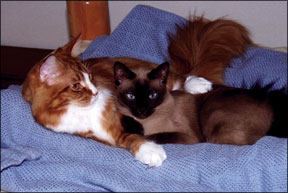Last months column outlined some pros and cons of adopting a second cat. There was no easy answer to give, of course. Some cats are social and seek the companionship of others. Other cats do not welcome the proximity of fellow felines. And many cats appear eager or at least willing to share, but only with certain individuals. Bev Caldwell 288 Let us assume that you followed last months tips and found an ideal mate for your resident cat. The newcomer is calm, playful and friendly. He appears relaxed when gently handled, and does not hiss or growl at his neighbor cats. And so, you have enthusiastically brought him home.
Now what? I have heard rumors about people who bring a new cat home, gladly announce its arrival, then tell the cats to “be good” as they head out to buy some new cat supplies. These lucky people return home to find their two cats sleeping peacefully in a sunbeam.
Apparently, then, such cold-turkey introductions can work. But what if they do not? There is of course the risk of physical injury. Possibly more detrimental than a bite wound, though, would be the effect of psychological trauma. Once a cat is frightened in a given context or by a given person or animal, he may never fully recover. Why take that chance?
Slow and Steady Works Best
Instead, I recommend a slow and steady approach. This conservative approach will involve separating the cats physically and visually for a few days – longer, if necessary. While the cats are separated, rub them daily with a common towel. This will help to initiate the exchange of friendly pheromones.
Each day, allow the cats to explore the house. As one cat explores, the second cat should be safely confined elsewhere. The free cat will sniff the environment. There will probably be some facial marking. The new cat will use this opportunity to learn the layout of his home. He will discover handy hiding places as well as comfortable resting places. Remember, he must be able to move confidently on his own before he is face-to-face with the resident cat.
With each day of independent exploration, the investigation process should grow shorter and less intense. The cats should be calm at the beginning and end of their individual sessions. They should spend less time sniffing and more time engaging in activities such as eating, playing or resting.
At this point, it is time to introduce the cats to each other through a barrier. A screen door or stacked baby gates work perfectly. Begin by giving each cat some delicious food. Place a dish on either side of the barrier, as far from the barrier as possible. The cats should eat their meals from this safe distance and then show curiosity, but not aggression.
Remember, stares, hisses and growls are all aggressive gestures. They indicate that the cat is prepared to engage in a physical confrontation or to run away. Your job is to distract a cat at the first sign of fear or aggression.
If the cats are not threatening each other, then let them remain on opposite sides of the barrier for the rest of the session. They can become familiar with each other from their safe vantage points. Be alert at all times – you cannot afford to miss a threat!
After a few sessions in which you have kept the cats comfortably apart, move the food dishes a little closer. Your goal is to have them eating side-by-side across the barrier. Watch for signs of friendly intentions. These may include rubbing across the barrier, quietly meowing or gently pawing the barrier.
Once there are friendly overtures with no hisses or growls, try raising the barrier a couple of inches – leave room for them to bat a toy back and forth. Let them touch feet in this manner so that they learn to trust each other in play.
Finally, when the play and feeding sessions seem to be positive experiences for all concerned, you may prepare to remove the barrier. It can be helpful to have the cats wear leashes and harnesses in the event that gentle restraint is needed. Plan to have a heavy blanket or water bottle handy to safely stop a pounce.
Keep your eyes and ears open. Be ready to intervene at the first indication of aggression or fear. For the next few days, continue to separate the cats when you are not able to supervise. You dont want to come home to any surprises. Soon enough, you will be able to relax and enjoy your companions. v



